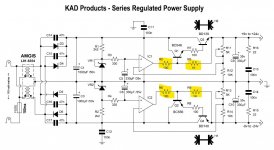The part in the circle is a 20uf tantalum cap that was requested by users that had oscillating 12 volt regulators.
I used a 22uf tantulum but have not powered it up yet. It IS polarized AFAICT so be sure and orient it correctly.
Ok thanks. Kind of what I thought but wasn't sure what value. I'm assuming that I can use 22uf 16volt or higher. I'll do my best to orient correctly.
The R values can be seen in #246 as well, 47k and 10k.
That oval thing is not a resistor and wasn't present on earlier versions either.
That oval thing is not a resistor and wasn't present on earlier versions either.
I just received the PCBs and I started to solder the components. But in the files that I got I have two different PSU schematics regarding some component values. I attach both of them. Please advise which are the correct values for R5, R6, R9, R10 resistors.
Attachments
Thank you very much for your quick response.Both work but PSU2 is most correct. Jan Didden suggested the values in PSU2 as an improvement. Thanks Jan.
Is this PSU better than a LM317 supply?Both work but PSU2 is most correct. Jan Didden suggested the values in PSU2 as an improvement. Thanks Jan.
I think it is, but I invite other to disagree, altho a LM317/ LN337 combo can be very good as well.
It seems rather artificially overengineered to me. It also doesn't have short circuits or temperature handling. If it had less noise, okay.
It seems rather artificially overengineered to me. It also doesn't have short circuits or temperature handling. If it had less noise, okay.
If you know how to improve the PSU, I invite you to document your revised circuit on this thread. If your change is worthy members will quickly embrace it and I will integrate it to the PCB.
see jan comments on PSU1 design oversight Post # 1404Both work but PSU2 is most correct. Jan Didden suggested the values in PSU2 as an improvement. Thanks Jan.
Hi,
new to this thread and looking at the information. I cannot find the part number of the rca connectors on the BOM from dropbox. tks.
new to this thread and looking at the information. I cannot find the part number of the rca connectors on the BOM from dropbox. tks.
Those at Mouser are dimensioned different than the ones we provide but should work fine if you are doing your own PCB layout.
If anyone is looking for more of the RCA quad connector blocks that we ship with the kit, we have loads on hand.
Can anyone tell me if I can use CK1054 Rotary switch instead of CK1059 that is mentioned in BOM?
Inspired by the discussion here about an IR controllable version of this preamp, I have started again to think of possible solutions. I have had many ideas which I often discussed with @Carl_Huff (thank you, Carl, for your time - I wouldn't have come this far without your help). Most of the ideas were quickly discarded, and some made it to a design/routing phase. Finally, I implemented a concept which allowed me to re-use the preamp PCB and the +-15V supply PCB:
Some impressions:
Front:

Digipots:

Modified IO board:

Everything combined:

Example splash screen 😉

So far, I haven't done measurements yet but the preamp sounds good to me (=without audible noise/distortions) which is my primary goal. Nevertheless, there are things left to be done which I will follow up step by step:
Any hints/suggestions/questions are always welcome!
- I designed a PCB to hold MCP41HV51 digipots which fits exactly on the original preamp PCB as a replacement of the mechanical pots. Luckily, I had one of these PCBs already at hand from an earlier try 😉
- The IO PCB needed a few modifications:
- separate grounds for audio/relays
- low side relay switching with an ULN2003
- updated 12V supply
- for my convenience: selectable relay supply (onboard/external) and selectable output delay control (onboard/external)
- As microcontroller I am finally using an Adafruit Grand Central M4 Express which can be programmed using the Arduino IDE and many of the Arduino libraries can be used, too. Originally, I had used an Arduino Mega 2560 which caused a lot of headache to me as it turned out to be the source of hizz in my setup.
- I added a small RGB OLED (small enough to fit into a 1U case) and a rotary encoder + switch.
- The digital stuff is powered by a small 5V SMPS.
Some impressions:
Front:
Digipots:
Modified IO board:
Everything combined:
Example splash screen 😉
So far, I haven't done measurements yet but the preamp sounds good to me (=without audible noise/distortions) which is my primary goal. Nevertheless, there are things left to be done which I will follow up step by step:
- Implement the IR control which I had honestly forgotten when designing the front panel 😉
- Implement using the big standby switch
- Cable cleanup
- Implement NVM storage of settings
- ...
Any hints/suggestions/questions are always welcome!
- Home
- Source & Line
- Analog Line Level
- Doug Self Preamp from Linear Audio #5

